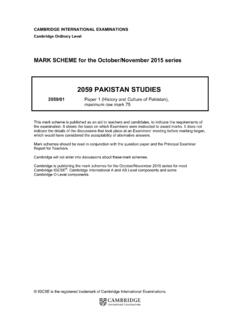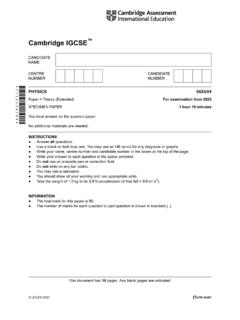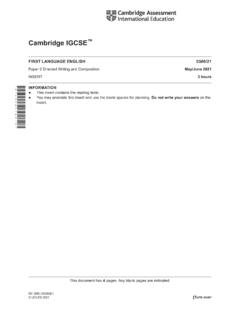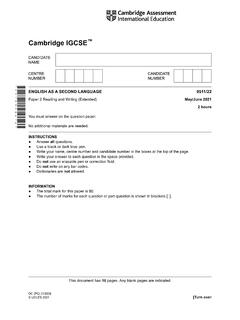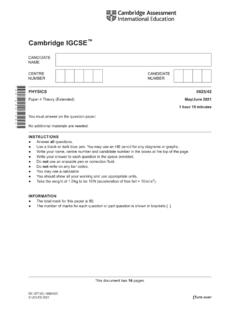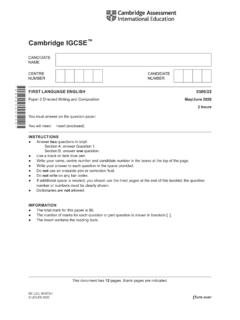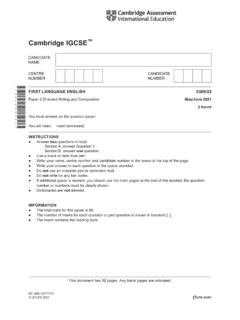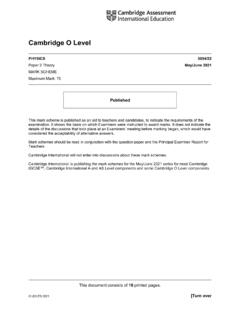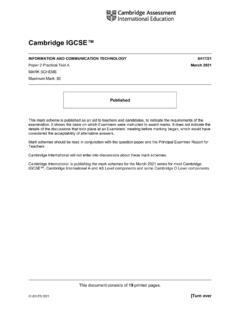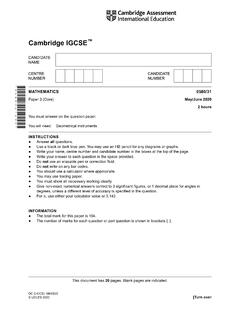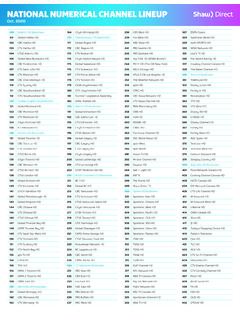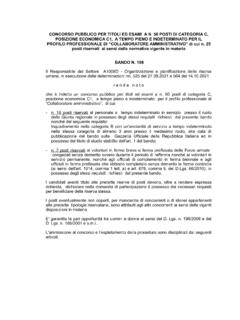Transcription of Cambridge International Examinations Cambridge Ordinary …
1 Cambridge International Examinations Cambridge Ordinary Level * 1 5 2 4 7 1 9 7 3 3 *. MATHEMATICS (SYLLABUS D) 4024/12. Paper 1 October/November 2015. 2 hours Candidates answer on the Question Paper. Additional Materials: Geometrical instruments READ THESE INSTRUCTIONS FIRST. Write your Centre number, candidate number and name on all the work you hand in. Write in dark blue or black pen. You may use a pencil for any diagrams or graphs. Do not use staples, paper clips, glue or correction fluid. DO NOT WRITE IN ANY BARCODES. Answer all questions. If working is needed for any question it must be shown in the space below that question. Omission of essential working will result in loss of marks. ELECTRONIC CALCULATORS MUST NOT BE USED IN THIS PAPER. The number of marks is given in brackets [ ] at the end of each question or part question. The total of the marks for this paper is 80.
2 This document consists of 20 printed pages. DC (LK/SG) 100474/4. UCLES 2015 [Turn over 2. ElEctronic calculators must not bE usEd in this papEr 1 (a) Evaluate . Answer .. [1]. (b) Evaluate 5 2(3 ) . Answer .. [1]. 2 (a) A trader buys 7 items for $ each and 5 items for $ each. He sells all of them for $10 each. Calculate his profit. Answer $ .. [1]. (b) Find the simple interest on $450 for 5 years at 4% per annum. Answer $ .. [1]. UCLES 2015 4024/12/O/N/15. 3. 3 y varies directly as the square root of x. Given that y = 18 when x = 9, find y when x = 4. Answer y = .. [2]. 4. f(x) = 1 + 4x 2. (a) Find f `- j . 5. Answer .. [1]. (b) Find f 1(x). Answer f 1(x) = .. [1]. UCLES 2015 4024/12/O/N/15 [turn over 4. 5 (a) Write the number 462 correct to 3 significant figures. Answer .. [1]. (b) By writing each number correct to 1 significant figure, estimate the value of #.]]
3 Answer .. [1]. 0 3 1 5. 6 Evaluate 3 c m- 2 c m. -3 1 -4 -1. Answer [2]. UCLES 2015 4024/12/O/N/15. 5. 7 (a) In the diagram, seven small triangles are shaded. Shade two more small triangles, so that the diagram will then have rotational symmetry of order 3. [1]. (b) In the diagram, ten small hexagons are shaded. Shade one more small hexagon, so that the diagram will then have exactly one line of symmetry. [1]. 8 a, b, c, d and e are five numbers, such that d < a < c a < e < c a < b < e Arrange these numbers in order, starting with the smallest. Answer .. , .. , .. , .. , .. [2]. smallest UCLES 2015 4024/12/O/N/15 [turn over 6. 9 At an athletics event, Dave and Ed each threw a javelin. Dave threw 60 m, correct to the nearest 10 metres. Ed threw 61 m, correct to the nearest metre. (a) Write down the lower bound for the distance thrown by Dave. Answer .. m [1].]
4 (b) Calculate the greatest possible difference between the distance thrown by Dave and the distance thrown by Ed. Answer .. m [1]. 10 (a) Express the number 004 5 in standard form. Answer .. [1]. (b). p = 6 108 q = 4 107. Expressing each answer in standard form, find (i) p q, Answer .. [1]. (ii) p q. Answer .. [1]. UCLES 2015 4024/12/O/N/15. 7. 3 0. 11 (a) Evaluate c m . 2. Answer .. [1]. 3 -1. (b) Evaluate c m . 2. Answer .. [1]. (c) Simplify (9x3)2 . Answer .. [1]. 12 (a) Express 198 as the product of its prime factors. Answer .. [1]. (b) M = 22 3 52 N = 23 32 7. (i) Find the largest number that divides exactly into M and N. Answer .. [1]. (ii) Find the smallest value of k, such that M k is a cube number. Answer k = .. [1]. UCLES 2015 4024/12/O/N/15 [turn over 8. 13. z y 77 . 20 45. 78 . x These two quadrilaterals are congruent. The lengths are in millimetres.]
5 Find the values of x, y and z. Answer x = .. y = .. z = .. [3]. 14 Meeraa went on a journey from P to Q to R. The first part of the journey, from P to Q, took 4 hours to travel 80 km. (a) Find the average speed for the journey from P to Q. Answer .. km/h [1]. (b) In the second part of the journey, from Q to R, she travelled 45 km. Her average speed for both parts of the whole journey from P to Q to R was 25 km/h. Find the time taken for the second part of the journey, from Q to R. Answer .. hour(s) [2]. UCLES 2015 4024/12/O/N/15. 9. 15 (a) On the Venn diagram, shade the set B + (A , C )l . B. A. C. [1]. (b) % = { 10, 11, 12, 13, 14, 15, 16, 17, 18, 19 }. W = { x : x is a multiple of 2 }. H = { x : x is a multiple of 3 }. (i) Find n (W H ). Answer .. [1]. (ii) List the members of W + H l . Answer .. [1]. UCLES 2015 4024/12/O/N/15 [turn over 10. 16 (a) Factorise (i) 4p2 9q2, Answer.]
6 [1]. (ii) 2n2 + 5n 3. Answer .. [1]. 3 2. (b) Express + as a single fraction. 4x 3y Answer .. [1]. UCLES 2015 4024/12/O/N/15. 11. 17. B T. A. O. x . 62 . 70 C. y . z . E D. In the diagram, A, B, C, D and E lie on the circle, centre O. AC is a diameter. The tangent to the circle at C meets the line AB produced at T. t = 62 and ACD. ACB t = 70 . (a) Find x. Answer x = .. [1]. (b) Find y. Answer y = .. [1]. (c) Find z. Answer z = .. [1]. UCLES 2015 4024/12/O/N/15 [turn over 12. 18. y C B. A. O x The sides of the triangle ABC are formed by the straight lines with equations 1. x = 3, y = 6, y = x+ . 2. (a) The region inside the triangle is defined by three inequalities. Write down these three inequalities. Answer .. [2]. (b) The point (4, k), where k is an integer, lies inside the triangle. Find the value of k. Answer k = .. [1]. UCLES 2015 4024/12/O/N/15. 13. 19 All the angles of a polygon are either 155 or 140.]
7 There are twice as many angles of 155 as 140 . Find the number of sides of the polygon. Answer .. [3]. UCLES 2015 4024/12/O/N/15 [turn over 14. 20 The masses of 400 goats were measured. The results are shown in the cumulative frequency graph. 400. 300. Cumulative frequency 200. 100. 0. 58 60 62 64 66 68 70 72. Mass (kilograms). (a) Use the graph to find (i) the median, Answer .. kg [1]. (ii) the 30th percentile, Answer .. kg [1]. (iii) the number of goats whose mass is more than 66 kg. Answer .. [1]. (b) It was noticed later that the scales used were faulty and that the true readings should all be 2 kg more. On the grid above, draw the true cumulative frequency graph. [1]. UCLES 2015 4024/12/O/N/15. 15. 21 The diagram shows the positions of three ships A, B and C. It is drawn to a scale of 1 cm to 20 km. (a) Find, by measurement, the bearing of C from A. Answer.]
8 [1]. (b) On the diagram construct the locus of points, inside triangle ABC, that are (i) equidistant from B and C, [1]. (ii) equidistant from AB and BC. [1]. (c) A ship D is equidistant from B and C, and equidistant from AB and BC. Label the position of D on the diagram and find the actual distance of D from A. Scale:1 cm to 20 km B. North A. C. Answer DA = .. km [1]. UCLES 2015 4024/12/O/N/15 [turn over 16. 22 P is the point (1, 3) and Q is the point (7, 2). (a) Find the coordinates of the midpoint of PQ. Answer ( .. , .. ) [1]. (b) Find the gradient of the line PQ. Answer .. [1]. (c) The line, L, with equation 2x 5y = k, passes through the point Q. (i) Find the value of k. Answer k = .. [1]. (ii) The line x + Ay = 3 is parallel to L. Find the value of A. Answer A = .. [1]. UCLES 2015 4024/12/O/N/15. 17. 23 A fair 4-sided spinner is numbered 1, 2, 3 and 4.]
9 (a) Anil spins it once. He gets his score by doubling the number obtained. Complete the table to show the probabilities of his scores. Score 2 4 6 8. Probability [1]. (b) Billie spins it twice. She gets her score by adding the numbers obtained. (i) Complete the possibility diagram. First spin + 1 2 3 4. 1 2 3 4 5. Second 2 3 4 5 6. spin 3 4 5 6 7. 4. [1]. (ii) Complete the table showing the probabilities for some of Billie's scores. Score >2 >4 >6 >8. 15. Probability 16. [1]. (c) Find the probability that Billie scores more than Anil. Answer .. [2]. UCLES 2015 4024/12/O/N/15 [turn over 18. 24 The first term of a sequence is 13. The following terms are found by alternately adding 4 and 6 to the previous term. The first six terms are 13 17 23 27 33 37. (a) Write down the next two terms of the sequence. Answer .. [1]. (b) Write down the value of the term that is closest to 999.]
10 Answer .. [1]. (c) Write down the difference between the values of the 91st and 93rd terms. Answer .. [1]. (d) Find the 80th term. Answer .. [1]. (e) The nth term is 203. Find n. Answer n = .. [1]. UCLES 2015 4024/12/O/N/15. 19. 25. 20. 15 car A. Speed (m/s) 10. 5. 0. 0 10 k Time (t seconds). The diagram shows the speed-time graph of car A. (a) Find the acceleration of car A when t = 7. Answer .. m/s2 [1]. (b) Find an expression, in terms of k, for the distance moved by car A between t = 0 and t = k, where k 2 10 . Give your answer in its simplest form. Answer .. m [2]. (c) Car B travels at a constant speed of 12 m/s in the same direction as car A. (i) On the diagram, sketch the speed-time graph of car B. [1]. (ii) When t = 0, car B passes car A. When t = k, car A overtakes car B. Find the value of k. Answer k = .. [1]. Question 26 is printed on the next page UCLES 2015 4024/12/O/N/15 [turn over 20.]
